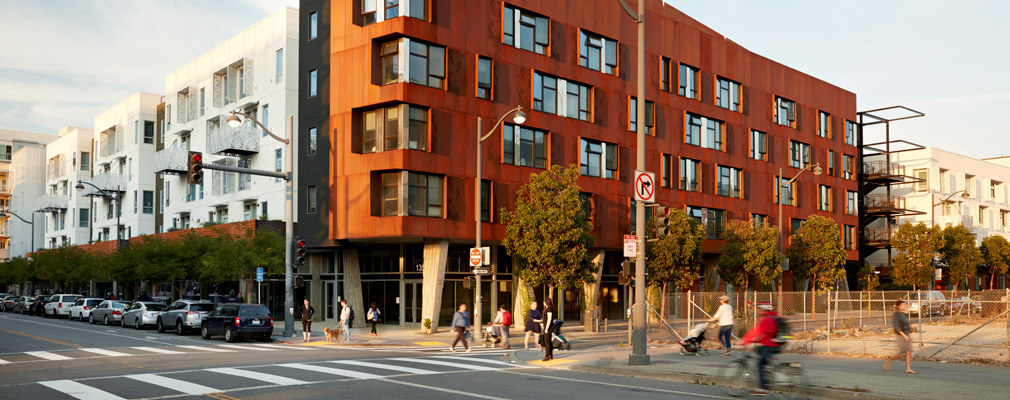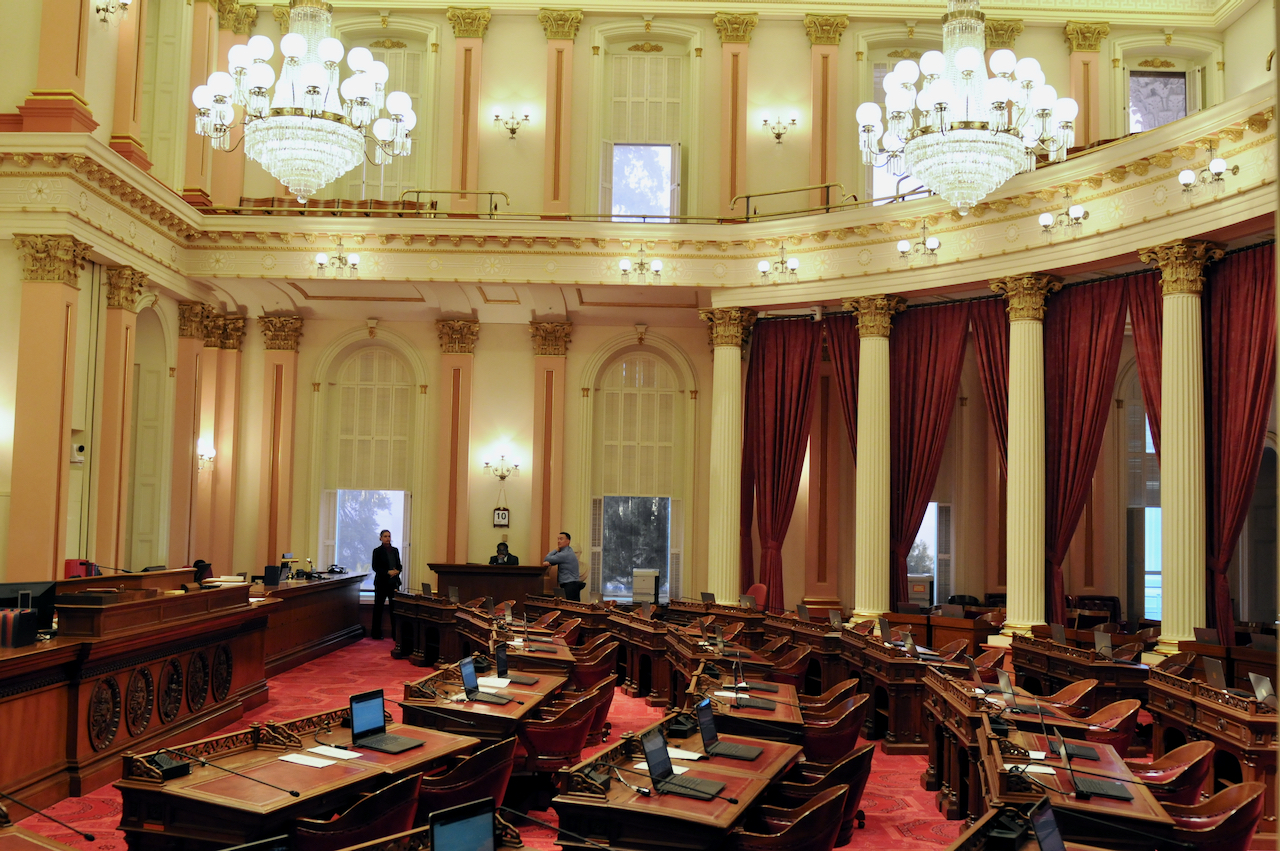
San Francisco: proposed Affordable Housing. (Photo: HUD.gov)
State Legislature Continues Its Assault On Local Zoning Decisions
YIMBYs support legislation that mandates high density
By Edward Ring, May 6, 2020 6:00 am
With the introduction of the latest housing density mandate, AB 725 in the California state legislature, the battle between state control and local control in California intensifies. At the same time, the pandemic crisis and its economic consequences add additional complexity to an already complex issue.
The debate over California’s housing policies offers an unusual combination: vehement disagreement between two bitterly opposed groups, yet within both groups are factions holding thoroughly divergent political ideologies.
This probably should come as no surprise. California’s housing crisis, and the policies that created it, incorporate big, challenging issues: income inequality, how to treat the homeless, environmental protection, public finance. Libertarians and leftists, along with Republicans and Democrats, are lining up on both sides of the debate, confounding easy categorization.
A grassroots organization fighting to preserve local control over residential zoning decisions is Livable California, founded by SF Bay Area activists in opposition to state legislation that would override local control of zoning laws. In less than two years, Livable California has grown its direct statewide membership to well over ten thousand, and has networked with allied groups that have hundreds of thousands of members.
If you follow the money, however, Livable California’s opposition, California YIMBY (“Yes in my backyard”), is far better funded. Receiving millions in support mostly from Bay Area tech moguls, California YIMBY and allied organizations lobby for state legislation mandating high density housing, as well as sue cities that resist existing state laws mandating high density.
Needless to say, YIMBY groups are adored by the media and have sprung up around the world. But in California they haven’t resolved a fundamental economic problem: The price of housing construction is so high that the only high density projects that get built are either luxury high rises that displace low income communities, or a small number of fabulously expensive “low income” housing units that only a small number of low income families will ever occupy.
The Livable California website shows their opposition to an assortment of high density legislation, AB 725 chief among them. According to Livable California, among other things, AB 725 “would open thriving working-class and middle-class neighborhoods to speculation and buy-outs, destroying housing to make way for up to 30 units of apartment housing per acre in metro counties, 20 units per acre in suburban counties, 15 per acre in cities in rural counties, and 10 per acre in unincorporated areas,” and “it openly targets single-family and low-density areas for high-density development — whether the community is served by transit or not.”
Some of the bills that Livable California have opposed must be seen to be believed. AB 3173 (still active) provides incentives for developers to build 80 square foot “micro-units” – at least that’s a bit larger than the 70 square feet that the American Correctional Association recommends as the minimum size for a prison cell! SB 902 automatically up-zones single family areas to six units or more per parcel. AB 1279 designates “opportunity areas” where housing could be up-zoned to high rises accommodating as many as 120 units per half-acre.
YIMBYs, on the other hand, support legislation that mandates high density. They want massive up-zoning of existing cities and suburbs. Within their odd coalition, the libertarians want zoning laws all but scrapped and expect the private market to swoop in to construct massive new supplies of housing. The leftists, on the other hand, want massive government borrowing to construct affordable housing and massive ongoing government spending to subsidize the rent payments.
No matter which YIMBY solution prevails, corporate developers alongside speculative investors stand ready to demolish aging inner city tenements and leafy residential suburbs alike, regardless of their current vitality or the wishes of the inhabitants.
Names matter. Opposed to the California’s YIMBYs are not so-called “NIMBYs” (not in my backyard); those favoring local control consider their opponents’ choice of “YIMBY” for a name to be a clever ruse to stigmatize them as NIMBYs. But the issue, say the opponents to YIMBYs, is over who makes zoning decisions. Local residents, or the state government?
Keith Gurney, a member of Livable California’s board of directors, explaining their position, said “we are not NIMBYs because we recognize there is an affordability crisis, and we support things we believe will mitigate the affordable housing crisis. If a city council wants to build high density, we will not argue with that. But the affordability crisis is a result of the state policy that tries to channel population growth into constrained boundaries. There is no way that stacking and packing in San Francisco will lower rents and purchase prices. This three year binge of state legislation trying to cram high density housing into low density neighborhoods is the wrong way to go.”
Livable California’s president, Rick Hall, expanded on this, saying “the gospel of high density and mass transit, and destroying existing residential neighborhoods in order to stay within the urban constraint will not lower housing affordability. There are places in this state where you can build a house for $250,000 with no subsidy. We support companies starting up satellite offices in places where housing can be constructed much more affordably.”
Livable California founder Susan Kirsch has disputed the estimated shortage of 3.5 million homes, claiming it is a pretext for pushing through top-down housing policy. But this calls into question a more fundamental question: What happens if the supply of housing in California is so huge that housing does become affordable?
This is far from academic. A crash in the value of housing requires a commensurate crash in the costs to build homes – which would require extraordinary deregulation – otherwise California’s private homebuilding industry would die off completely. As it is, private developers cannot afford to build low or middle income housing in California without subsidies. But what else would happen?
If California’s housing prices ever fell significantly, millions of homeowners would be underwater on their mortgages, unable to move and struggling to pay in a presumably down economy. The only way out of this would be broad based inflation, raising wages which would make it easier to pay fixed rate mortgages. And of course, property tax revenues would fall, adding additional stress to municipal government budgets.
Legislative solutions that Livable California does support include SB 795 which would fund expanded infrastructure and resources to serve additional housing, and SB 1299 which would provide incentives to repurpose idle big box retail and strip malls with housing.
The YIMBYs, with a torrent of money coming from big tech, real estate developers, and big finance, will never take on the elephant in the room, which is the state legislature’s ongoing effort to establish and strengthen urban containment polices. Until developers can construct entire new cities on open land within California’s vast Central Valley, along the Highway 101 corridor, and elsewhere, the only thing that will make housing affordable will be an economic collapse.
The uncomfortable truth is that years of neglected infrastructure, defacto rationing, and urban containment legislation have already taken away much of the local control that would have allowed Californians to expand their cities and towns, and keep housing affordable.
Livable California, a genuine grassroots movement, has the potential to reverse this trend. If successful, they may eventually alter the policy driven economic conditions that prohibit lasting solutions. The YIMBY movement, on the other hand, funded by billionaires, will never solve California’s housing crisis, because they aren’t questioning the doctrine of densification. But so what? Their donors will see their real estate portfolio investments soar into bubbleland, as they virtue signal all the way to the bank.
- Ringside: EVs and California’s Future Demand for Electricity - December 4, 2025
- Ringside: Politically Viable Water Supply Projects - November 27, 2025
- Ringside: Shifting Costs Does Not Solve California’s Electricity Shortages - November 20, 2025




Ring writes, “Livable California founder Susan Kirsch has disputed the estimated shortage of 3.5 million homes, claiming it is a pretext for pushing through top-down housing policy.” You don’t have to take my word for the over-inflated number. The Orange County Register (1.27.20) blasted the headline, “Newsom admits he stretched housing truth about a 3.5M unit shortfall,”
https://www.ocregister.com/2020/01/27/newsom-admits-he-stretched-housing-truth-about-a-3-5-million-unit-shortfall/
As long as section 8 housing is required in gated communities and rapist/child molesters are required to live next the judge’s family…
It is good to see Ed Ring write articles that are not related to pensions. His abilities can truly help the state if he takes time to focus on issues that impact everybody on a daily basis, like the issue in this article. Good to see the effort here. That’s all.
Edward Ring has become one of a very few star writers on California policy today.
Every column is a “must-read” because he gives you the straight dope on the behind-the-curtain machinations of the politicians, bureaucrats, and their cronies.